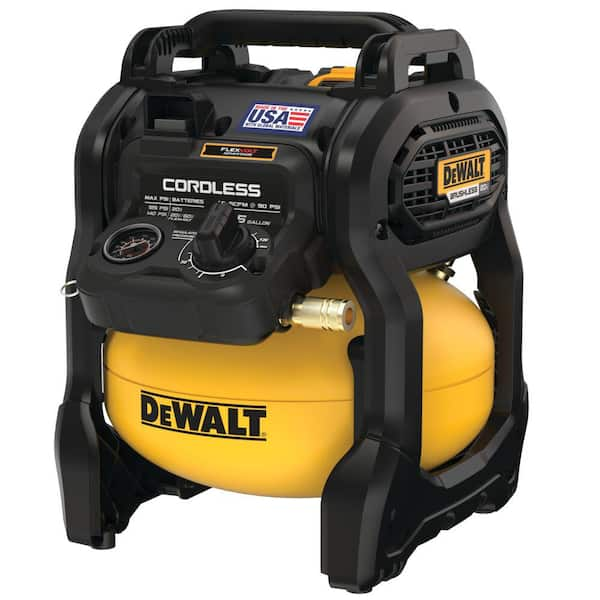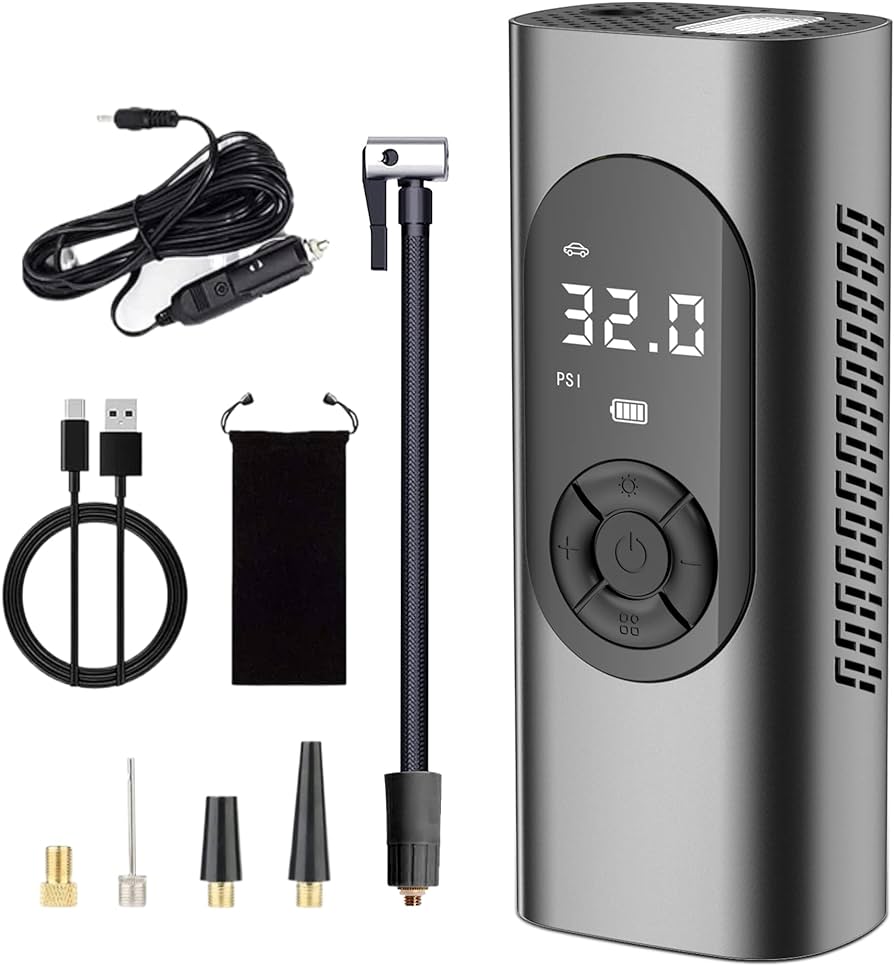Always read the manufacturer’s manual before use and ensure the cordless air compressor is on a stable surface during operation. Wear safety glasses to protect your eyes from potential debris.
Cordless air compressors offer the convenience of portability and the absence of power cords, thus enhancing safety and flexibility in various settings. Whether you’re inflating tires or powering tools, the right safety measures are crucial. Simple yet effective precautions such as securing a clear workspace, checking the equipment for defects before each use, and wearing personal protective equipment (PPE) can significantly minimize risks.
Keeping your air compressor in optimal condition through regular maintenance is also key to ensuring long-term safety and performance. By following these practices, you can benefit from the functionality of your cordless air compressor while maintaining a safe environment for yourself and those around you.
What Safety Precautions To Follow
Cordless air compressors offer the convenience of portability along with the power needed for various tasks, from inflating tires to powering pneumatic tools. Despite their user-friendly design, it’s critical to handle these devices with care to prevent accidents and ensure a safe working environment. By following a set of essential safety precautions, users can minimize risks and maintain a secure operational process. Here’s a look at the key safety measures to consider when using a cordless air compressor.
Read The Manufacturer’s Manual Before Use
Understanding your equipment is paramount. Each cordless air compressor comes with its own set of specifications, capabilities, and safety instructions. Before powering on the device for the first time, take the time to:
- Review the manual thoroughly to familiarize yourself with the compressor’s features and limitations.
- Identify proper operation procedures to lower the chance of malfunctions.
- Know the recommended maintenance schedule to keep the compressor in top condition.
Wear Appropriate Personal Protective Equipment (ppe)
Personal Protective Equipment (PPE) shields you from unexpected hazards. To maximize safety, ensure you wear:
- Safety goggles to protect your eyes from airborne debris.
- Ear protection, like earplugs or earmuffs, if working in a noisy environment.
- Work gloves to safeguard your hands during operation and maintenance.
Always choose PPE that complies with safety standards relevant to the tools being used.
Ensure The Compressor Is On A Stable, Flat Surface
Stability is essential for both safety and optimal performance of your cordless air compressor. Follow these steps to prevent tip-overs and vibration-related issues:
- Locate a flat, even surface where the compressor can sit securely.
- Check for any movements or vibrations after the compressor starts; reposition if necessary.
- Keep the area around the compressor clear of obstructions to provide a safe working radius.
Inspecting Your Cordless Air Compressor
Regular inspection of your cordless air compressor is not just a safety measure; it’s a necessity. Before diving into any project, ensure your tool is up to the task. A thorough inspection can prevent malfunctions that may lead to injury or damage to your projects. Let’s go over the critical checks that should be part of your pre-use routine.
Check For Any Visible Damage Or Wear
Diligent examination of your air compressor’s body and components is essential. Look for any signs of cracks, abrasions, or other imperfections. Here’s what to keep an eye on:
- Housing: Ensure it’s free of cracks or deformities.
- Knobs and adjustments: Confirm they operate smoothly without any resistance.
- Feet and stands: Check for stability and inspect for wear.
Verify The Battery Is Correctly Installed And Charged
The source of power for your cordless compressor matters greatly. Perform the battery check:
- Ensure the battery pack snaps firmly into place without any loose connections.
- Check the charge level to make sure it’s sufficient for intended use.
- Visually inspect the battery terminals for corrosion or dirt and clean if necessary.
Examine All Hoses And Fittings For Integrity
The hoses and fittings are the lifelines of your compressor. A compromised hose or fitting can quickly escalate to a safety hazard. Consider these steps:
| Hose Inspection | Fittings Check |
|---|---|
| Assess hoses for any punctures, kinks, or brittle areas. | Ensure all fittings are secure and free of rust. |
| Confirm there are no leaks, using a soap and water solution if necessary to detect subtle ones. | Check for cross-threading or stripping that might compromise an airtight seal. |
Maintaining the integrity of these components will not only extend the life of your cordless air compressor but also keep the operation safe and efficient.
Engaging Safely With The Air Compressor
An electrifying addition to any DIY toolkit, the cordless air compressor is the epitome of convenience and portability. Yet, it’s crucial to interact with this powerful device with respect and caution to ensure a safe and efficient experience. Battling the elements, tending to inflatables, or powering pneumatic tools, safety remains paramount. Let’s deflate the risks and pump up your safety knowledge as we explore essential precautions to consider when utilizing your cordless air compressor.
Keeping clear of hot surfaces during useKeeping Clear Of Hot Surfaces During Use
Hot surfaces on a compressor are not just a byproduct; they’re an invitation for burns if not respected.
- Identify which components heat up during operation, typically the motor housing and exhaust.
- Allow the compressor to cool down before handling it or performing any maintenance.
- Equip yourself with heat-resistant gloves if needed, particularly when you need to move the compressor or change attachments.
Maintaining Awareness Of Surroundings To Prevent Accidents
Accidents can be prevented with a keen sense of one’s environment. Chords and nearby objects could pose tripping or snagging hazards. Keep these tips in mind:
- Clear the area of unneeded objects that can cause accidents.
- Ensure stability on even ground to avoid compressor tip-over.
- Inform others in the vicinity to be mindful of the operating compressor.
Adjusting Pressure Settings According To The Tool’s Requirements
Too much pressure can damage tools and materials, while insufficient pressure can lead to improper tool function. Adhere to these practices:
| Tool Requirement | Action |
|---|---|
| Manufacturer’s PSI Recommendation | Adjust compressor to match or slightly exceed setting |
| Varied PSI Needs | Be prepared to adjust frequently between tasks |
Regularly check and adjust the pressure gauge to align with the tool’s operational sweet spot for optimal, safe performance.

Credit: www.homedepot.com
After Use: Securing The Air Compressor
Just finished a project with your trusty cordless air compressor? Great work! Now, let’s talk about securing your device post-operation. Proper storage of your compressor is crucial not only for maintaining its lifespan but also for safety reasons. Here’s how you can ensure your air compressor rests safely between uses, so it’s ready and in top condition for the next job.
Allow The Compressor To Cool Down Before Storing
Cordless air compressors can become quite hot during use. Give it time to cool before you put it away. This minimizes the risk of heat-related damage to the compressor or storage area and reduces the likelihood of burns or accidents.
- Place the compressor in a clean, dry area.
- Avoid direct sunlight or extreme temperatures.
- Wait until the compressor is cool to the touch.
Disconnect The Battery And Store It Separately If Recommended
For some models, maintaining peak battery life means disconnecting it once you’re done. Check your manufacturer’s guidelines and, if advised, remove the battery. A few pointers to note:
| Storage Tip | Benefit |
|---|---|
| Keeping the battery in a cool, dry place | Prevents moisture damage and overheating |
| Storing the battery separately | Reduces the risk of accidental activation |
Clean And Inspect The Compressor Before Storage
Always clean away dirt and debris from your compressor. A simple wipe-down can prevent long-term damage and ensure your tool is ready for its next use.
- Inspect hoses and attachments for wear or damage.
- Clean the air filter to maintain airflow and performance.
- Examine the compressor body for any signs of damage or leaks.
Your cordless air compressor is a valuable tool – treat it as such! Take care during cleanup and storage, and you’ll extend its life considerably, ensuring it’s always ready for action.
Mitigating Risks When Using Cordless Compressors
Employing a cordless air compressor empowers productivity and flexibility in various tasks, ranging from inflating tires to powering pneumatic tools. Yet, it’s imperative to observe strict safety measures to avert potential hazards. Adherence to safety guidelines not only extends the lifespan of your device but also ensures your well-being.
Regularly Check For Leaks And Address Promptly
Conducting routine inspections for any signs of air leakage in a cordless air compressor is critical. Leaks can lead to energy waste, reduced efficiency, and potentially hazardous situations. Ensuring that all connections are secure, hoses are intact, and valves are functioning properly stands paramount in compressor maintenance.
- Power off the compressor and release pressure.
- Examine all hoses, fittings, and connectors for wear and tear.
- Listen closely for hissing sounds that indicate air escape.
- Apply soapy water to suspect areas and watch for bubbles.
- Immediate action is necessary if leaks are detected. Tighten, seal, or replace defective components without delay.
Understand The Signs Of Compressor Failure Or Overheating
Being proactive about the health of your air compressor includes recognizing symptoms of a faltering or overheating unit. Signs to look out for include unusual noises, vibrations, or an excessively hot surface. These indicators could signify internal wear, obstruction of airflow, or a malfunctioning motor.
- Overheating: Touching surfaces gingerly to assess any abnormal heat elevation.
- Noise and vibration: Listening for grinding, screeching, or banging sounds; feeling for excessive shaking.
- Performance issues: Noting any decrease in pressure or irregular cycling patterns.
Cease operation at the first sign of trouble and consult the manual or a professional for further diagnosis and repair.
Be Aware Of Emergency Shut-off Procedures
Understanding the emergency shut-off protocol contributes greatly to user safety. In the event of an emergency, knowing how to power down your cordless compressor quickly can prevent injuries and damage to the unit.
| Step | Action |
|---|---|
| 1 | Locate the emergency shut-off switch/button. |
| 2 | Press or flip the switch/button to the ‘Off’ position. |
| 3 | Disconnect the power source, if possible. |
| 4 | Evacuate the area, if necessary, to ensure personal safety. |
Regularly familiarize yourself with the compressor’s manual and emergency procedures. Practice them periodically to ensure you can execute them swiftly and correctly during actual emergencies.
Frequently Asked Questions On What Safety Precautions Should I Follow When Using A Cordless Air Compressor?
What Are The Essential Cordless Air Compressor Safety Tips?
When using a cordless air compressor, ensure it’s on a stable surface. Keep it away from water and moisture to prevent electrical hazards. Always wear eye protection to guard against airborne debris.
How To Properly Maintain A Cordless Air Compressor?
Regularly check for leaks and ensure the battery is charged. Clean the air filter and release any condensation from the tank after use. Store the compressor in a dry, clean environment to prolong its lifespan.
Can A Cordless Air Compressor Overheat?
Yes, a cordless air compressor can overheat if used excessively without breaks. Always allow the unit to cool down after extended use. Follow the manufacturer’s recommendations for duty cycles to prevent overheating.
What Protective Gear Is Recommended When Operating A Compressor?
Ear protection is recommended to prevent hearing damage from noise. Gloves will protect your hands, while safety goggles will shield your eyes from flying particles. Always dress appropriately to avoid entanglement with moving parts.
Conclusion
Safeguarding yourself during cordless air compressor usage is paramount. Always prioritize user manual instructions, proper attire, and protective gear. Keep your workspace clear, maintain regular inspections, and stay mindful of temperature conditions. Embrace these steps for uncompromised efficiency and safety.
Remember, responsible handling is the key to longevity for both your tool and your well-being.

